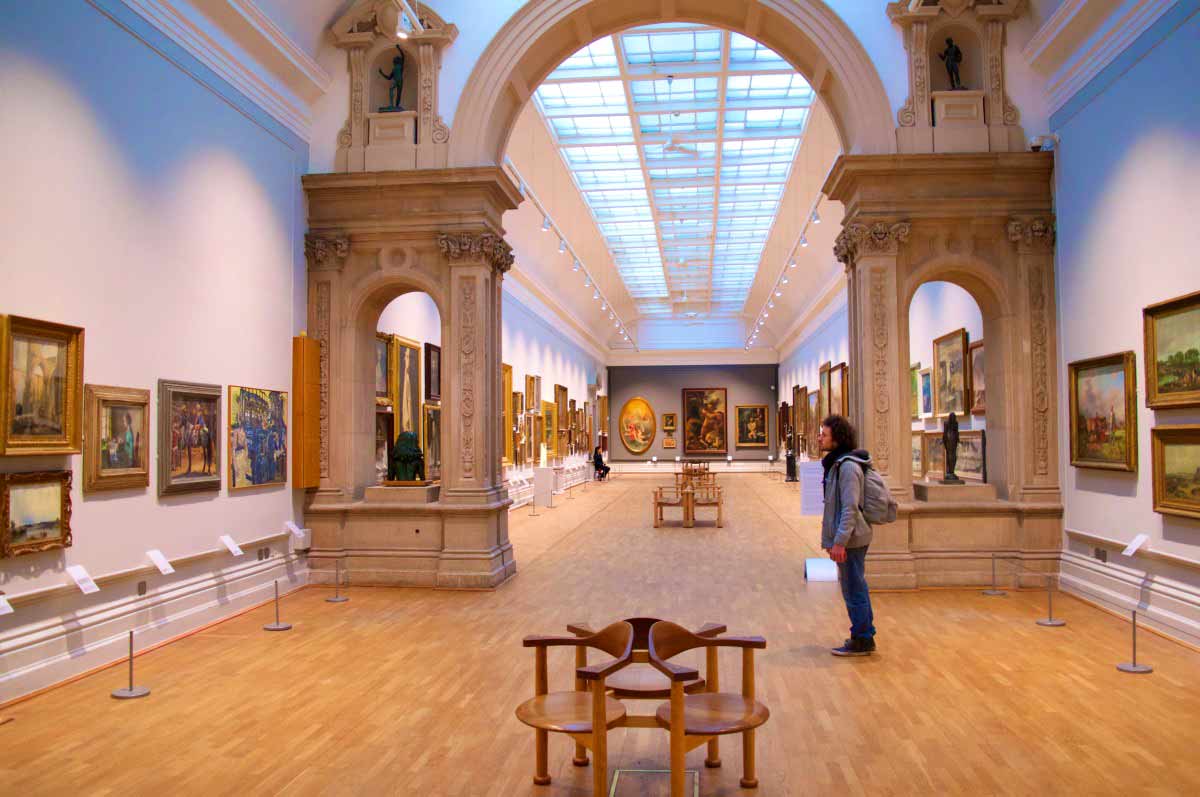Many of us show curiosity and interest to know Louvre Museum facts. The Museum du Louvre is located in the Seine of Paris and has made it the second most visited museum after the Palace Museum in China, though it is still the largest. In its early days, the Louvre served a defensive purpose. King Philip II initiated its construction in the 12th century as a fortress to safeguard against potential English invasions. Its formidable construction earned it a reputation as a nearly impenetrable stronghold, reflecting the strategic importance of the site during medieval times.
This article will give an overview of Louvre Museum facts. Keep reading
Interesting Louvre Museum Facts
During World War II, the Louvre Museum faced significant challenges. When the original artworks were cleared out for protection, the museum’s empty spaces were used as a storehouse for paintings confiscated from Jewish families by Nazi officials. This period of history highlights the museum’s role in safeguarding art during times of conflict, making it one of the intriguing facts about the Louvre Museum’s wartime experiences. Here are some more interesting Louvre Museum facts to know:
1. The Largest Museum in the World
The Louvre Museum, situated in the heart of Paris, proudly bears the distinction of being the largest museum on the planet. This accolade extends not only to the vastness of its art collection but also to the sheer physical size of the museum itself. Encompassing an expansive area, the museum’s galleries alone span an impressive 652,300 square feet, which is equivalent to a sprawling 15 acres. This immense space is essential to accommodate the millions of eager visitors who flock to explore its cultural treasures each year. i’way: Private car service to and from 600 airports worldwide
2. Wolfish Origins of the Name
The intriguing name of the Louvre Museum has a fascinating connection to both nature and history. Its etymology can be traced back to the French word “loup,” which translates to “wolf” in English. This naming choice harks back to a bygone era when the vicinity surrounding the Louvre was a forest inhabited by these enigmatic creatures. To safeguard against the presence of wolves, strategic fences were erected along the banks of the nearby Seine River, thus giving rise to the name “Louvre” as a reminder of this wolfish past.
3. World’s Largest Art Museum
The Louvre’s status as the world’s largest art museum is nothing short of awe-inspiring. Its extensive and diverse collection comprises an astonishing 380,000 pieces of artwork, effectively spanning a jaw-dropping 731,945 square feet or 80,000 square meters. This remarkable size is a testament to the museum’s unwavering commitment to preserving and showcasing the rich tapestry of human artistic expression in all its forms and eras.
4. Public Access Since 1793
The Louvre Museum holds the esteemed position of being not only a historic institution but also the first national museum in France. This cultural landmark made history in 1793 by opening its doors to the public. At that time, it displayed a modest collection of just over 500 works of art. This momentous decision was driven by a profound aspiration: to rival the artistic heritage of Rome and, more importantly, to make art and culture accessible to all citizens. This commitment underscored ideals of democracy and cultural enrichment.
5. Protection During WWII
The invaluable artworks housed within the Louvre faced a grave threat during the tumultuous period of World War II. However, the tireless and dedicated efforts of Jacques Jaujard, a senior civil servant, ensured the preservation of many of these priceless treasures. Jaujard masterminded the removal of over 4,000 pieces of art, carefully concealing them in the safety of a Loire Valley Château. This extraordinary undertaking served as a bastion of protection for the artwork, shielding it from the ravages of war.
6. Nazi Headquarters During WWII
World War II etched a somber chapter in the Louvre’s storied history when it fell under the control of the Nazis, serving as their headquarters in Paris. The museum endured this occupation until the liberation of the city by Allied forces. This dark period underscores the Louvre’s resilience in the face of adversity and the enduring spirit of art and culture.
7. Iconic Pyramid Designed by I.M. Pei
The contemporary glass pyramid that graces the entrance of the Louvre is a striking architectural masterpiece. Designed by the renowned American architect I.M. Pei in 1989, its selection initially sparked controversy among locals. However, over time, it has transformed into an iconic symbol not only of the museum but also of the city of Paris itself. This modern pyramid seamlessly melds the aesthetics of modernity with the grandeur of the museum’s historical architecture, serving as a welcoming gateway to the world of art within.
8. Most-Visited Museum on Earth
The Louvre’s universal appeal is undeniably evident in its consistent ranking as the most-visited museum globally. In the year 2018 alone, this cultural treasure welcomed an astonishing 10.2 million visitors. This remarkable figure firmly establishes the Louvre as not only a guardian of human heritage but also as a premier tourist attraction in Paris. Its enduring popularity and frequent appearances in popular culture serve as a testament to its unrivaled global significance in the realm of art and culture. Create publish-worthy videos on day one
9. Its Beginnings as a Fortress
The Louvre’s history is a fascinating journey that traces back to its origins as a fortress. Built-in the 12th century during the reign of King Philippe Auguste, it initially served as a defensive tower safeguarding the city’s perimeter. At that time, Paris was encircled by protective walls constructed in 1190, and the Louvre played a crucial role in fortifying the city. As centuries passed, the Louvre underwent transformations, evolving from a fortress into a grand palace before eventually assuming its role as one of the world’s most renowned museums in 1793.
10. The Stature of the Louvre Pyramid
One of the most iconic features of the Louvre is its striking glass pyramid, designed by the renowned Chinese architect I.M. Pei and unveiled in 1989. This modern architectural masterpiece stands nearly 70 feet tall and serves as the main entrance to the museum. The Louvre Pyramid has become an emblematic symbol not only of the museum but also of the city of Paris itself. Its bold and innovative design makes a profound statement, welcoming visitors from around the world at the ground-level entrance.
11. From Modest Beginnings
The Louvre’s journey as a museum began after the 1789 French Revolution when it was designated as the nation’s primary showcase for its artistic treasures. However, when it first opened its doors as a museum, its collection was relatively modest, consisting of just 721 works of art. Over the centuries, the Louvre’s collection has undergone remarkable expansion and diversification, and today, it houses approximately 400,000 works of art. Among these, a staggering 35,000 pieces are on public display, representing a wide array of artistic genres and historical periods.
12. The Immensity of Its Collection
The sheer size and scope of the Louvre’s collection are awe-inspiring. To put it into perspective, if a visitor were to spend only 30 seconds examining each piece of art in the museum, it would take an astonishing 100 consecutive days to see everything in the Louvre’s holdings. This remarkable fact underscores the immense wealth of artistic treasures that the Louvre safeguards and its status as one of the world’s most significant cultural institutions.
13. Napoleon’s Influence
Napoleon Bonaparte, a figure of immense historical significance, left his mark on the Louvre in a bold manner. Upon his ascent to power in France in 1799, he officially renamed the Louvre as the “Musée Napoleon” in 1802. Napoleon had a deep personal connection to the museum, and he demonstrated this by placing the world-famous Mona Lisa in his private bedroom for his personal enjoyment. This association with a powerful ruler further elevated the Louvre’s status in the world of art and culture.
14. The Size of the Mona Lisa
The Mona Lisa, undoubtedly one of the most iconic artworks in the Louvre, is smaller in real life than one might imagine. The painting measures just 21 by 30 inches, slightly larger than a standard sheet of paper. Despite its modest dimensions, the Mona Lisa has achieved international fame and recognition. Today, it is housed behind bulletproof glass to protect it and its legacy. Interestingly, the painting had a tumultuous history, as it was famously stolen in 1911, only to be recovered two years later, adding to its mystique. Ticket for Events
15. A Haunted Legacy
Legends and folklore have given rise to stories of the Louvre’s haunted legacy. According to some tales, a mummy known as “X” is said to reside within the museum’s confines. Additionally, there have been reported sightings of a ghostly man in red attire strolling through the adjacent Jardin des Tuileries. These eerie legends add an air of mystery to the Louvre’s rich history, captivating the imagination of visitors.
16. Part of the Axe Historique
The Louvre is not just a standalone attraction but a pivotal component of the “axe historique,” an architectural alignment of monuments that spans westward through the heart of central Paris. Stretching just over three miles, this historical axis places the Louvre at its core, serving as the fulcrum between iconic landmarks such as the Arc de Triomphe, the Grande Arche of La Défense, and the Place de la Concorde. This alignment provides a perfect route for sightseeing in the city, offering a grand architectural narrative that showcases the historical and cultural richness of Paris. The Louvre’s central position within the “axe historique” underscores its integral role in the city’s grand tapestry of landmarks.
17. The Mona Lisa Debate
The identity of the woman depicted in the Mona Lisa has been a subject of debate and intrigue. Officially, the Louvre identifies her as Lisa Gherardini, the wife of Francesco del Giocondo, a Florentine silk merchant. However, experts have conflicting opinions. Some believe that Lisa Gherardini was confused with another Lisa, Lisa del Giocondo.
An alternative theory suggests that the woman in the painting might be Pacifica Brandano, the mistress of Giuliano D’Medici, who gave birth to a son named Cardinal Ippolito D’Medici. The ongoing debate about the true identity of the Mona Lisa adds to the mystique of this famous artwork and is one of the enduring mysteries associated with the Louvre.
18. When Lisa Was Stolen
In 1911, the Mona Lisa was stolen from the Louvre, and while it was eventually recovered, this event left a lasting impact. Many visitors who came to see the empty space on the wall where the painting once hung left notes, flowers, and other mementos as a form of mourning. This episode in the Mona Lisa’s history, including the public’s emotional response, is a fascinating part of the Louvre Museum’s past. Events made easy: All the tools you need to effortlessly manage your events on WordPress
19. Suspicion
Pablo Picasso is a name synonymous with art, and his fame is so enduring that there’s even an application based on his work. Interestingly, a missing painting attributed to Picasso led to suspicion. However, it was later discovered that the real culprit was an employee of the Louvre, Vincenzo Perugia. He was a criminal who had stolen the Mona Lisa with the intention of trying to sell it to an art dealer in Florence. This unexpected twist in the Mona Lisa’s history showcases the intrigue and mystery that has surrounded the painting over the years and highlights the lengths to which individuals have gone to possess this iconic masterpiece.
20. On the ghost side
Belief in ghosts is a highly personal and subjective matter, often influenced by cultural, religious, and individual factors. The Louvre Museum, despite being a renowned institution, has had its share of ghostly stories. There have been reported instances of paranormal activities within the museum, including encounters with what some believe to be ghosts. One famous anecdote involves a mummy named Belfigo, who is said to have exhibited eerie behavior at night. Additionally, the nearby Tuileries Garden, with its long and storied history, is also associated with ghostly legends and sightings. While these tales may or may not hold any factual basis, they add an element of mystique to the already intriguing museum.

21. Many Have Tried To Damage the Mona Lisa
The Mona Lisa, one of the world’s most famous paintings, has faced several attempts at vandalism and damage over the years. As a result of these incidents, the painting is now displayed behind bulletproof glass to protect it. In one notable case, an individual threw a bowl at the Mona Lisa in an attempt to damage the artwork. Fortunately, the bowl shattered upon impact, causing no harm to the painting or its protective glass. These incidents highlight the extraordinary measures taken to safeguard this iconic masterpiece.
22. The Louvre Is the Third Try at a Good Name
The Louvre Museum in Paris has undergone several name changes throughout its history. When it first opened in 1793, it was known as the Muséum des Arts. Later, during the time of Emperor Napoleon, it was renamed Musée Napoleon after the emperor himself. Finally, it received the name “the Louvre,” likely as a reflection of Napoleon’s more limited international appeal compared to other historical figures. Despite these changes, the museum has retained its status as one of the world’s most renowned cultural institutions. Get matched with a Career Advisor and Mentor who will help you select and enroll in the right program for you.
23. 25% of All Leonardo da Vinci Paintings Are in the Louvre
Leonardo da Vinci, the Renaissance genius, is known for his enigmatic and highly sought-after works of art. Unlike some of his contemporaries, da Vinci didn’t produce a vast number of paintings. Instead, he left the world with only 24 known free-standing works of art. Within this limited collection, six of these paintings are housed in the Louvre Museum, making it the custodian of a significant portion of da Vinci’s artistic legacy. This includes renowned pieces like the Mona Lisa and the Virgin on the Rocks.
24. Immense Size and Rich Collection
The Louvre Museum is an architectural marvel, boasting an immense size that covers nearly 800,000 square feet (73,000 square meters). Within its vast expanse lies an unparalleled collection of art and historical treasures. From world-famous paintings like the Mona Lisa to ancient Egyptian artifacts, the Louvre’s collection spans centuries and civilizations, making it a treasure trove for visitors.
25. Home to World-Famous Artworks
What truly sets the Louvre apart is not just its size but its exceptional collection. It serves as the home to some of the most renowned works of art globally, earning its reputation as a must-visit destination for art enthusiasts and history buffs alike. The museum’s collection includes masterpieces by artists like Leonardo da Vinci, Michelangelo, and the ancient Greek sculptor Venus de Milo, ensuring its place as a custodian of human artistic achievement.
26. An 800-Year History
The Louvre’s rich history dates back to the 12th century when it was originally constructed by King Philip Augustus as a centralized building for his new capital, Paris. Over the centuries, it underwent multiple transformations, evolving from a fortress to a royal residence and ultimately into a world-renowned museum. Its longevity and evolution are testaments to its enduring significance.
27. The Grande Galerie
The Grande Galerie Has the Most Impressive Collection of the Louvre and No Mona Lisa. While the Mona Lisa is undoubtedly a masterpiece, the Louvre Museum boasts an extensive collection of art, and the Grande Galerie contains some of the most impressive works. This gallery features an array of Italian masters, including Raphael, Ghirlandaio, and Perugino, who contributed to the Renaissance, Baroque, and Classicism movements. While French artists like Théodore Géricault and Eugène Delacroix made significant contributions, the Grand Galerie showcases the Italian influence on art history. Da Vinci’s painting “Virgin on the Rocks” is among the notable pieces in this gallery.
28. Much of the Art was Stolen…Kind Of
During Napoleon’s reign as Emperor of France, the Louvre Museum witnessed a period of significant expansion and acquisition of art. Napoleon’s military campaigns resulted in the acquisition of numerous artworks, which were often considered war spoils. These artworks enriched the Louvre’s collection, including notable pieces like Jacques-Louis David’s “The Coronation of Napoleon.” Napoleon’s interest in art was so profound that he even placed the Mona Lisa in his bedroom at the Palais Tuileries. However, after his reign, most of the art acquired through war was eventually returned to their respective countries, and the museum reverted to its original name, the Louvre. Positive Parenting Products on Amazon for their Creative Kids
29. Architectural Line
The “Ax Historique” is a significant architectural feature that stretches for approximately 5 kilometers through the heart of Paris. This monumental axis runs from the central nucleus of the Louvre Museum, extending westward. Along this axis, several iconic landmarks are situated, creating a visual and symbolic connection between them. The Louvre itself serves as the starting point, and as one moves along the axis, they encounter the majestic Arc de Triomphe, the modernist masterpiece of La Défense known as the Grand Arch, and finally, the Obelisk of the Place de la Concorde. This alignment of landmarks not only provides a breathtaking visual perspective but also represents the historical and cultural significance of these sites in the city’s history and identity.
30. Year 2014 achieved a remarkable milestone
In 2014, the Louvre Museum achieved a remarkable milestone by welcoming over 9.3 million visitors. This impressive figure underscores the museum’s enduring appeal and its status as one of the world’s most visited cultural institutions. Since its opening to the public, the Louvre has consistently drawn an enormous number of art enthusiasts, historians, tourists, and curious minds from around the globe. The fact that it continues to attract such a large audience, even centuries after its establishment, speaks to the enduring fascination people have with its extraordinary collection of art and artifacts.
31. Napoleon Era
The era of Napoleon Bonaparte is a significant chapter in the history of the Louvre Museum, particularly concerning its most famous resident, the Mona Lisa. When Napoleon came to power, he took a keen interest in art and culture, which led to the Mona Lisa being hung on the wall of his bedroom. This placement not only underscored the painting’s importance but also demonstrated Napoleon’s appreciation for its artistic value.
However, the painting faced numerous challenges during times of conflict. To protect the Mona Lisa, it was moved to a secret location during periods of unrest, including the Franco-Prussian War and World War II. This action was taken to safeguard the masterpiece from potential damage or theft, highlighting the painting’s enduring significance and the lengths taken to ensure its preservation during turbulent times in history.
32. Not so big
The Mona Lisa, an iconic masterpiece by Leonardo da Vinci, is celebrated worldwide for its cultural significance and artistic excellence. However, one might be surprised to learn that the physical dimensions of this renowned painting are rather modest. Measuring approximately the size of an A2 paper sheet, the Mona Lisa spans a mere 16.5 x 23.4 inches (42 x 59.4 cm). Despite its unassuming size, this portrait of a woman with an enigmatic smile continues to captivate art enthusiasts and historians alike, highlighting the idea that true greatness often transcends physical dimensions.
33. All French
The Louvre Museum in Paris stands as a global beacon of art and culture, home to an extensive collection of artworks representing diverse cultures and historical periods. However, a fascinating statistic reveals that a substantial 66% majority of the paintings housed within the Louvre are the creations of French painters. This dominance underscores the profound artistic heritage of France, showcasing the country’s remarkable contributions to the museum’s diverse and multifaceted collection.
34. Transcript
The mention of a second Louvre Museum opening in Abu Dhabi in late 2016 is likely an outdated or erroneous piece of information. In actuality, the Louvre Abu Dhabi made its highly anticipated debut on November 11, 2017. This monumental project was the result of a collaborative effort between France and the United Arab Emirates, featuring an extraordinary array of artworks from around the world. Serving as an extension of the Louvre brand, the Louvre Abu Dhabi has since become a cultural landmark in the region, fostering international appreciation for art and heritage.
35. Napoleon nomenclature
The Louvre Museum’s history bears witness to the shifting tides of political power and influence. During the reign of Napoleon Bonaparte, the museum was initially christened the “Musée Napoléon” in honor of the emperor. However, following Napoleon’s downfall in 1814, the museum underwent a significant name change. It was then rechristened as the Louvre Museum, a name that endures to this day and is universally recognized in the realm of art and culture. Books, and literature on Amazon.
36. 100 days worth of a tour
The Louvre Museum’s vastness and unparalleled collection are nothing short of awe-inspiring. To comprehend the sheer scale of this cultural treasure trove, consider this staggering estimate: If a visitor were to spend a mere 30 seconds observing each painting displayed within the museum, it would require an astonishing 100 days to cover the entirety of the collection. This statistic underscores the museum’s remarkable depth and breadth, emphasizing the necessity of multiple visits to fully savor and appreciate its artistic riches.
37. The museum is not a museum
The Louvre’s storied history is marked by intriguing transformations. Originally established as a fortress during the late 12th century, in the era of King Philip II, the Louvre evolved significantly over the centuries. Gradually, it shed its military origins and transformed into a grand palace during the late 16th century. It was only later that the Louvre assumed its current identity as a renowned art museum. This transition from fortress to palace to museum reflects the site’s remarkable architectural and historical journey.
38. Mona’s own
The Mona Lisa, undoubtedly one of the most famous artworks within the Louvre, enjoys a level of adoration and fascination that few other pieces can claim. The painting’s immense popularity has led to an intriguing phenomenon—it has its very own dedicated mailbox. This mailbox serves as a repository for the countless love letters, fan mail, and messages of admiration sent by visitors and art enthusiasts from around the world. This unique tradition not only underscores the enduring allure of the Mona Lisa but also underscores the profound impact of art on the human soul, transcending boundaries and captivating hearts for generations.
More Interesting Articles
- List of Caribbean Countries’ Flags and Their Capitals
- List of Scandinavian Countries – Capitals | Flags | Nordic
- Flags of Latin American Countries – Capitals | Population | Economy
- List, Capitals, and Flags of South American Countries
- Flags of North American Countries in Alphabetical Order
- Oceania Countries and Flags in Alphabetical Order
- Nordic Countries List – Capital | Flags | Population | Area
- List of Caribbean Countries in Alphabetical Order
- All-State Flags of the United States of America – Pictures | Images
- Alphabetical Order Flags of African Countries and Their Names
- All South Asian Countries Flags with Names
- Southeast Asian Countries and Their Flags
- Individual National Flags of Asian Countries with Names
- National Flags of European Countries with Names
- Names of Countries Flags – Flags of the World with Names
- Country Code List – Alpha-2 | Alpha-3 | Numeric | Phone
- US National Holidays – List of Holidays in America
- United States Embassies and Consulates – List with Link
- Time Zones List by Country – World Time | UTC | GMT | standard
- 2 Letter Country Codes – ISO 2-Digit Alpha Abbreviation



